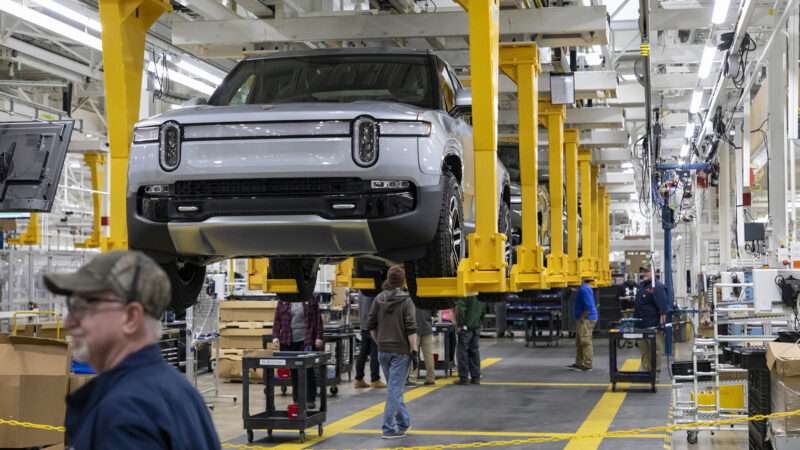
An upstart electric vehicle manufacturer that has struggled despite generous taxpayer-funded incentives is now asking for a federal loan.
Rivian, builder of luxury electric trucks and SUVs, operates out of a single factory in Illinois. But it announced in December 2021 that it would build a second factory in Georgia; state and local governments, in turn, offered the company a number of incentives worth as much as $1.5 billion.
In the years since, the company's fortunes have dipped. When Rivian went public in November 2021, investors valued the company at $90 billion, higher than Ford or General Motors. Less than two years later, however, the company's stock price, and cash on hand, had plummeted. Bloomberg reported in May 2023 that the company's valuation "now stands at less than $12 billion after a 93% stock wipeout, reflecting almost no value beyond the company's cash hoard." By the third quarter of that year, the company was losing more than $43,000 on each vehicle it sold.
Bloomberg cited multiple analysts who were skeptical of Rivian's ability to compete in an increasingly crowded market. One analyst said it would need to raise at least $4 billion to fund its growth beyond 2025, even though its incentive agreement required the company to spend $5 billion on its Georgia plant by 2028.
Rivian had always tied its future viability to that factory, which would allow the company to expand into more affordable fare. But in March, while announcing a less expensive line of R2 SUVs that would roll out in 2026, the company also revealed that it would pause construction at the second plant.
While "Rivian's Georgia plant remains an extremely important part of its strategy," the company said, it would instead continue building everything at its existing Illinois plant, with "total savings estimated to be over $2.25 billion as compared to the original forecast" of building out the second factory.
Then this month, the company petitioned the U.S. Department of Energy (DOE) for a loan under the Advanced Technology Vehicle Manufacturing (ATVM) Loan Program. While Rivian had previously planned to start building its R2 line in 2026, it currently doesn't even expect to break ground on the factory until the second quarter of that year, with preliminary production in 2027 and the "start of saleable production" pegged at the fourth quarter of 2028.
The application does not list a specific dollar amount, though it does demonstrate in the details just how much the company has already benefited from government assistance, even without any construction taking place. The state of Georgia owns the land and is leasing it to the company. So far, according to the application, state and local agencies have "initiated site development activities that involved course grading plans, cut and fill, soil preparation, initial site grading, temporary access roads, and development of 11 stormwater retention and detention features." The state Department of Transportation is also "completing transportation improvement projects on the site," such as building out Interstate 20 to accommodate traffic to, from, and around the facility.
While the state is handling the preparatory work, Rivian itself is responsible for the construction of the facility—though as its AVTM application makes clear, the company is hoping to depend on taxpayers to help out with that process, as well.
Despite its economic outlook, Rivian is not incapable of raising money from private sources: In June, the company announced that Volkswagen would invest between $1 billion and $5 billion into the company to jointly develop software for the automakers' respective vehicles. And yet it still hopes to rely on taxpayers to act as investors.
The AVTM program was established in 2007. A 2014 report by the Government Accountability Office (GAO) found that the DOE had only issued five loans so far, totaling $8.4 billion, while it had spent an additional $3.3 billion in borrowing costs. Three of those loans were successful, while the government lost $200 million on the other two.
"Unless DOE can demonstrate a demand for new ATVM loans and viable applications," the GAO report concluded, "Congress may wish to consider rescinding all or part of the remaining $4.2 billion in credit subsidy appropriations."
Instead, the program was expanded in 2022, when the Inflation Reduction Act removed the cap on loans that could be issued under the program, bringing its "total estimated available loan authority" to $55.1 billion.
Rivian is clearly doing its best to navigate uncertain waters: An Ernst & Young survey released in September found consumers' willingness to purchase an electric vehicle had declined 14 percentage points over the previous year, from 48 percent to 34 percent. The American Automobile Association similarly noted that while consumers are less willing to drive fully electric vehicles, they are increasingly willing to drive hybrids, which use gasoline along with electricity.
Pivoting its strategy in one direction or another makes perfect sense for any company, much less one still trying to prove itself in an unproven market. But just like with any other economic sector, Rivian should have to weather these challenges itself and not depend on state or federal taxpayers to help out.
The post Rivian Seeks Federal Loan To Restart Georgia Plant Despite $1.5 Billion in State Incentives appeared first on Reason.com.







